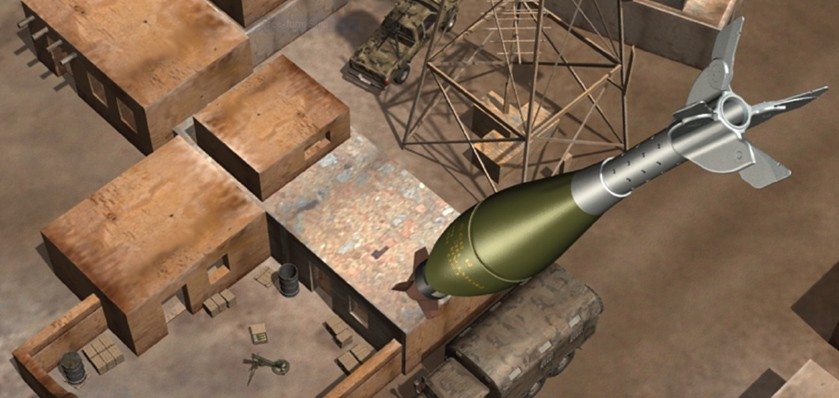This month, U.S. Soldiers in Afghanistan received 120mm GPS-guided mortar precision capability.
The Program Executive Office for Ammunition fielded Accelerated Precision Mortar Initiative cartridges, or APMI, to one Infantry Brigade Combat Team, or IBCT, earlier this month, and is scheduled to field cartridges to the seven other IBCTs in Afghanistan within six months.
“APMI is a 120mm GPS-guided mortar cartridge that provides the infantry commander precision-strike capability, which he has never had before,” said Peter Burke, PEO Ammunition’s deputy product manager, Guided Precision Munitions and Mortar Systems.
Mortars are an indirect firing capability used to defeat enemy troops, materiel, bunkers and other infantry-type targets.
“Typically mortars are fired in volleys against an area target because of their inherent inaccuracy, but with APMI, you have the potential to destroy a target with only one or two rounds,” Burke said.
The APMI cartridge has a requirement of 10 meters CEP, or Circular Error Probable, but Burke said the program is exceeding this requirement. Ten meters CEP means that if you drew a circle around a target at 10 meters radius, the rounds have to fall inside the circle 50 percent of the time.
Current CEP for 120 mm mortars at their maximum range is 136 meters. Mortars with the most advanced features, such as precision position and pointing systems, can achieve a 76 meter CEP, which still makes APMI seven times more accurate than any formerly fielded mortar.
While APMI will not replace standard 120mm mortars, its accuracy will allow a commander the ability to defeat a target with precision if there is danger of collateral damage, Burke explained.
Insurgents deliberately plan attacks in populated areas in the hope that opposing forces don’t want to retaliate and risk accidental harm to civilians or damage to non-military property.
“Sometimes, if the risk of collateral damage is too high, you might not be able to fire (a standard 120mm) at all,” Burke said of enemy engagements. “In that case, instead of firing a mortar from a protected position, you would have to send troops in to engage with direct-fire weapons, exposing them to more risk.”
But because of APMI’s GPS-technology, which provides an accurate, first-round fire-for-effect capability, troops will have opportunities to employ APMI’s precision where they previously would not, such as nearer to friendly forces or in urban areas.
Besides reducing risk to the local population and keeping U.S. servicemembers out of harm’s way, APMI reduces the logistical burden of ammunition resupply.
A mortar unit typically carries 25 High-Explosive, or HE, rounds with them, Burke said, and they will now carry a mixture of standard and APMI rounds. Instead of firing large quantities of HE rounds, troops can fire one or two APMI and eliminate the target, so their resupply needs should be reduced.
The APMI, Inside and Out
The APMI XM395, cartridge uses a standard M934 high-explosive 120mm projectile body. In the nose, a GPS receiver and computer controlled aerodynamic directional fins keep the round on its programmed trajectory. Folding fins in the tail provide stability.
APMI also has a multi-functional fuse, which allows the round to be programmed to explode in the air, once it hits a hard surface or after it penetrates inside a target.
In order for the autonomous flight and fuse control to function properly, operators must input mission and GPS data from a fire control computer into the round using a setting device.
Earlier PEO Ammunition program investments contributed to APMI’s development by providing technological building blocks and by paving inroads, including the 155mm Excalibur round and the Precision Guidance Kit, referred to as PGK. PGK is a low-cost, GPS-guided fuse kit that improves the accuracy of existing 155mm artillery rounds.
The Armament Research Development and Engineering Center, or ARDEC, co-located here, develops advanced fire control systems that help mortar operators improve the speed of their operations and the accuracy of their fires. These include the Lightweight Hand-held Mortar Ballistic Computer and the Dismounted 120mm Mortar Fire Control System, which were modified for the APMI fielding to ensure mortar operations remain streamlined.
“There were many difficult technological hurdles we crossed previously during our development of digital fire control systems requiring interface with smart projectiles that culminated in the APMI,” said Patti Alameda competency manager, of ARDEC’s Mortar and Common Fire Control Systems Division. “The ability of people to work as a team and integrate all of the sophisticated technology in a way that reduces the burden on the Soldier is really how we achieve this leap forward in capability.”
The APMI cartridge is fired from the M120 mortar system, which is compatible with the M326 Mortar Stowage Kit. Also developed at ARDEC, M326 Mortar Stowage Kits are now in full scale production and will be fielded to IBCTs over the next several years.
As of right now, Burke said there is no requirement for precision capability for 81mm and 60mm mortars.
The Army’s requirements for larger caliber precision munitions allow technology to be more easily adapted to these larger rounds, he said.
“The 120 gives you a lot more room to work with,” Burke said. “To fit all the electronics into smaller cartridges, with today’s technology, is not feasible. They started with the biggest size to give us the most room to work with. Plus, you’re getting the lethality of a 120, which is leaps and bounds above what a 60mm HE round can do.”










